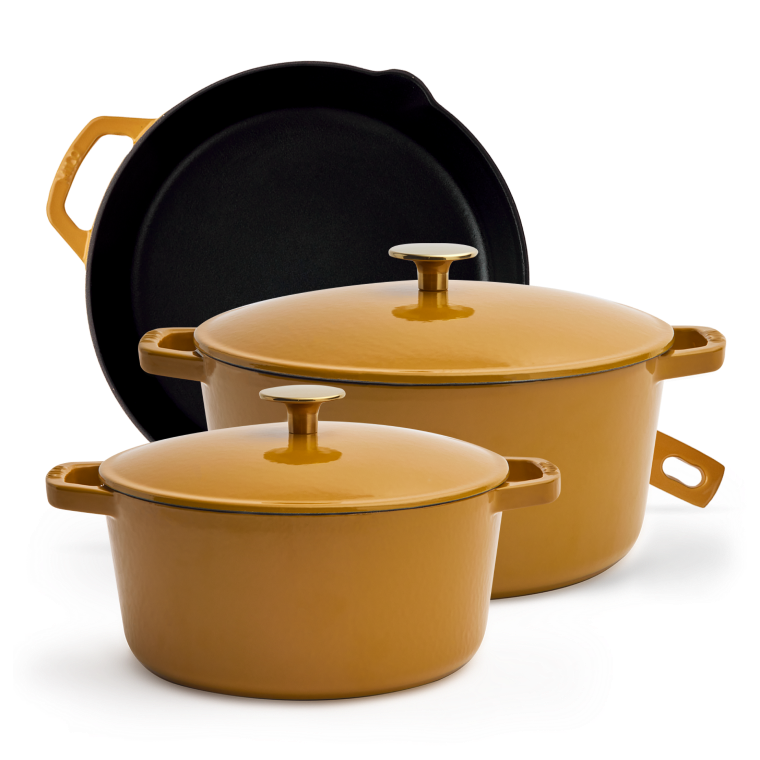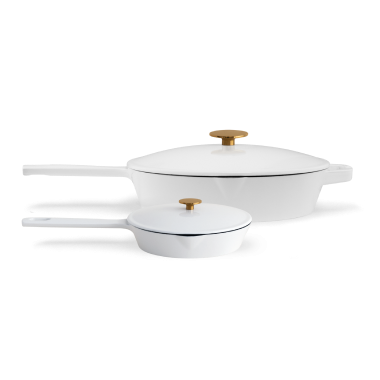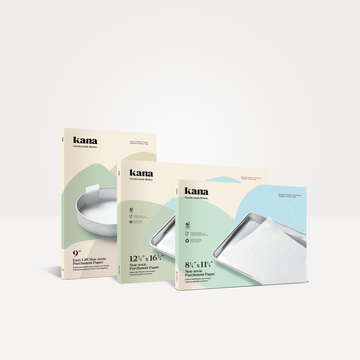As consumers, it's our responsibility to educate ourselves about the environmental footprint of our meals. While we may be decades away from a completely sustainable food chain, even the smallest choices we make at the grocery play a part.
Although it may not be something we consciously think about, what we put on our plates can be actually be causing harm to the planet. In fact, some foods are directly tied to deforestation, biodiversity loss, and inhumane labor practices.
With that in mind, here are some of the best foods with the least environmental impact to help you start making more environmentally decisions today.
5 sustainable foods to cook for an eco-friendly kitchen

Cooking with these environmentally-friendly ingredients is a simple way you can reduce the carbon footprint of your kitchen and live a more sustainable lifestyle today.
Lentils
This vegan favorite is an affordable, versatile, and highly nutritious ingredient—boasting 9 grams of protein per one-half cup. The best part is that getting lentils on to your plate involves very low levels of greenhouse gasses. Even during production and the post-farming process, lentil production still produces 40 times less carbon than meat protein sources. If you care about the traceability of your food and are looking for organically grown lentils, Flourist is a great option to consider, and they can be purchased online.
Lentils are also super simple to prepare; simply boil and they're ready to eat. You can use them as an ingredient in salads, as a substitute for rice, or as the base of a delicious Indian daal. Try using our Milo Dutch oven to make your next batch!
Lentils are also super simple to prepare; simply boil and they're ready to eat. You can use them as an ingredient in salads, as a substitute for rice, or as the base of a delicious Indian daal. Try using our Milo Dutch oven to make your next batch!

Potatoes
Potatoes are popular for their wide range of uses and cooking possibilities. Whether you'd like it fried, boiled, or roasted, you'll never run out of recipes with this powerhouse in your pantry.
Beyond all those perks, the biggest benefit is that potatoes are water-efficient crops, only consuming about 50 gallons per pound. Moreover, they produce natural pesticides, thereby eliminating the need for chemicals. Because potatoes can be stored for months without going bad, you'll also worry less about food wastage.
Beyond all those perks, the biggest benefit is that potatoes are water-efficient crops, only consuming about 50 gallons per pound. Moreover, they produce natural pesticides, thereby eliminating the need for chemicals. Because potatoes can be stored for months without going bad, you'll also worry less about food wastage.
Nuts
Nuts are another great low-carbon protein source, especially when compared to other protein sources like meat. Producing one kilogram of nuts creates 2.3 kilograms of CO2, while the same amount of beef creates a whopping 27 kilograms. Take note, however, that not all nuts are good for the planet. Almonds, for instance, demand massive amounts of water to produce so that's something you'll want to avoid.

Amaranth
Amaranth, which translates to 'everlasting' in Greek, is one of the oldest grains around. It was even an essential food source for ancient South American and Mexican civilizations. This resilient plant does not need much water to grow, and it can thrive in almost any soil condition. Amaranth is a great grain substitute when trying to eat gluten-free. Plus, it's surprisingly easy to prepare. Rice cookers that cook your favorite grains can be used to make amaranth too. Just use 1 part amaranth, and 2 parts water, and you'll have a hearty bowl in no time.

Tomatoes
When harvested locally, tomatoes have a low carbon footprint. What's more is that tomatoes—which are interestingly both fruits and vegetables—have a much more distinct, refreshing taste when homegrown. That's enough reason to support local agriculture! This vine is also quite simple to grow, and anyone can enjoy their own tomatoes from the comfort of their backyard. If you're looking for a delicious tomato-sauce recipe that can be made in bulk using your Milo Dutch Oven, check out The Ultimate No-Fuss Tomato Sauce recipe by Melanie Hadida!
Of course, this list only scratches the surface of sustainable dining. At the end of the day, eating well doesn't have to come at the price of the planet. With so many alternatives—and a wealth of information at your fingertips, too—there's no excuse not to make more responsible consumer choices.
Of course, this list only scratches the surface of sustainable dining. At the end of the day, eating well doesn't have to come at the price of the planet. With so many alternatives—and a wealth of information at your fingertips, too—there's no excuse not to make more responsible consumer choices.
Jennifer Birch is a freelance writer who aspires to live a zero-waste lifestyle. She is currently residing in Southern California, and enjoys indoor gardening in her spare time.
Keep exploring

April Fool's Day: Our Favorite Food Fake-Outs
These creative dishes from some of our favorite culinary creators will have you doing a double take!

5 deliciously easy flour-free bread recipes
Simple bread recipes to make at home when you're running short on wheat flour.

Demystifying gluten
You’ve definitely heard of gluten, but do you know how it plays a role in baking? Today we’re diving into the science behind gluten and sharing tips for understanding it in your baking.

An interview with Julia Estrada, Kana's newest baking queen
Julia Estrada is the face behind the delectable blog, Bread & Basil, and she certainly knows her way around the kitchen. Baking is her true love, and you'll often find her making artisanal breads in her New York City apartment.

5 tips on decorating Valentine's cakes for that special someone
Get creative on Valentine’s Day by offering your loved ones something baked from scratch and uniquely decorated. Here are some easy ways to shake up your cake decorating.

The proof is in the... proofing
The proofing process is an essential part of baking yeast-leavened goodies. Without it, you'll end up with a sad, flat pancake instead of that beautiful bread loaf you were hoping for. Yes, it takes some time to perfect the process, but once you've got it, you too can experience freshly-baked bread and pastries at home.

Celebrating women’s contribution to food history
Throughout history, women have been at the forefront of changing the way we look at food. From inventing the modern cooking show to coining the term “stir fry”, here are five women who have helped broaden the way we see and prepare food.

How to get your garden ready for spring
By April spring is in full swing and it’s the perfect time of year to start planning your garden. So while the April showers come down, get started with these simple steps that will help put a smile on your face as you watch your garden come together.

Gluten free pantry essentials to always have on hand
Having a well-stocked pantry is the key to successful gluten free cooking and baking.

5 successful strategies when cooking for large families
Mealtime doesn’t need to be stressful just because you have a lot of mouths to feed. Here are some simple strategies to decrease the time you spend preparing and cooking meals, and keep everyone (relatively) happy and complaint-free at the dinner table.

3 ways to cook turkey this holiday season
Turkey dinner is a steadfast tradition for many of us during the Holidays. From the benefits of brining to thinking twice about basting, here are three great ways to cook your turkey as part of a festive feast.

An interview with Julia Estrada, Kana's newest baking queen
Julia Estrada is the face behind the delectable blog, Bread & Basil, and she certainly knows her way around the kitchen. Baking is her true love, and you'll often find her making artisanal breads in her New York City apartment.

Recyclable, compostable, biodegradable: what's the difference?
Having a good handle on what’s recyclable, compostable, and biodegradable is just one way you can set yourself up to make decisions that are good for you and the planet.
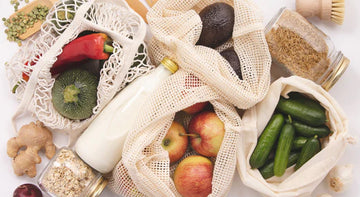
The problem of food waste (and what you can do about it)
There are few things quite as disappointing as seeing perfectly good food go to waste. Turns out it’s not just regrettable for food lovers, it’s a significant strain on the Earth, too.
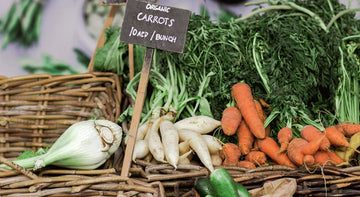
3 very good reasons to start shopping locally
When it comes to buying groceries and other goods from your local businesses, your dollar goes further than you think.

A guide to fresh home-grown herbs all year long
All the information you need to start growing a window box garden filled with fresh herbs for your favorite dishes.
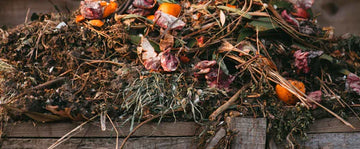
6 top tips on beginning your composting journey
Composting at home has become a great way to fertilize your garden while cutting down what goes into landfills. Here’s a quick guide and six tips to get you started on composting. It’s easier than you think.

How to get your garden ready for spring
By April spring is in full swing and it’s the perfect time of year to start planning your garden. So while the April showers come down, get started with these simple steps that will help put a smile on your face as you watch your garden come together.
